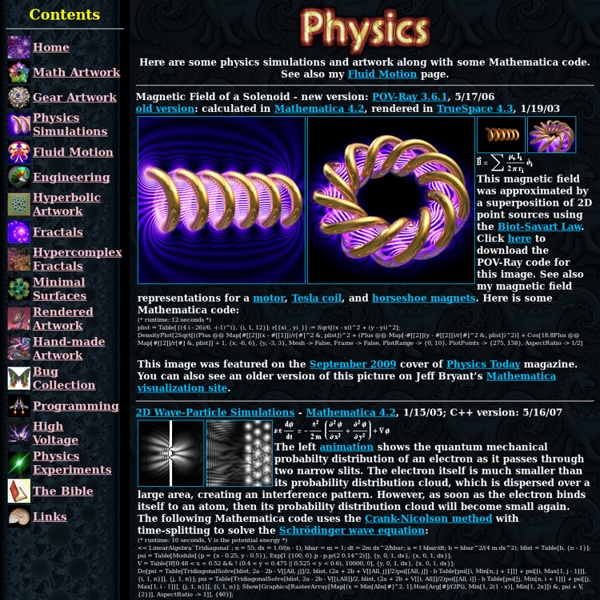Nature Publishing Group : science journals, jobs, and information
The Physics Classroom
Math, Physics, and Engineering Applets
Oscillations and Waves Acoustics Signal Processing Electricity and Magnetism: Statics Electrodynamics Quantum Mechanics Linear Algebra Vector Calculus Thermodynamics Mechanics Miscellaneous Licensing info. Links to other educational sites with math/physics-related information or java applets useful for teaching: And when you get tired of learning, here is some fun stuff: Pong Simulation Circuit-level simulation of original 1972 Pong.
This is What Happens When You Run Water Through a 24hz Sine Wave
What!? How is this even possible? Because science, my friends. Brusspup’s (previously) latest video explores what happens when a stream of water is exposed to an audio speaker producing a loud 24hz sine wave. Run the rubber hose down past the speaker so that the hose touches the speaker. Brusspup did a similar experiment last year where it looked as if the water was flowing in reverse.
Constellation
Exactly 1week to "Space Race - Yuri's Night 2014: Hunting Comets!" team challenge on BoincStats Hello everyone, in exactly one week the "Space Race - Yuri's Night 2014: Hunting Comets!" team challenge on BoincStats will start. There are already 14 teams in for for the Yuri's Night challenge and we hope to see more of you participating there. This is our annual team challenge to honor Yuri Gagarin, first human in space, and our own birthday. Comet Trails: An IMEX application for predicting meteor storms at spacecraft or planets AerospaceResearch.net is happy to announce the next application running on the Constellation platform, the "IMEX Cometary trails". Description: The "IMEX Comet trails" project is an ESA-funded project run at the Institute of Space Systems (IRS) at the University of Stuttgart to characterize dust trails produced by comets in the inner solar system. (click here for Youtube-video Dr. comet_trails_jupiter by aerospaceresearch.net on Flickr
"Twistor" Theory Reignites the Latest Superstring Revolution: Sc
In the late 1960s the renowned University of Oxford physicist and mathematician Roger Penrose came up with a radically new way to develop a unified theory of physics. Instead of seeking to explain how particles move and interact within space and time, he proposed that space and time themselves are secondary constructs that emerge out of a deeper level of reality. But his so-called twistor theory never caught on, and conceptual problems stymied its few proponents. Like so many other attempts to unify physics, twistors were left for dead. In October 2003 Penrose dropped by the Institute for Advanced Study in Princeton, N.J., to visit Edward Witten, the doyen of today’s leading approach to unification, string theory. Expecting Witten to chastise him for having criticized string theory as a fad, Penrose was surprised to find that Witten wanted to talk about his forgotten brainchild. Penrose’s original goal was to reconsider how quantum principles apply to space and time.
NetLogo Home Page
NetLogo is a multi-agent programmable modeling environment. It is used by many hundreds of thousands of students, teachers, and researchers worldwide. It also powers HubNet participatory simulations. It is authored by Uri Wilensky and developed at the CCL. You can download it free of charge. You can also try it online through NetLogo Web. Download NetLogo Go to NetLogo Web Getting Started with NetLogo Are you new to NetLogo or programming in general? The NetLogo tutorials guide you through all the basics, from loading and using models, to interacting with models with NetLogo code, and finally programming a model from scratch. When you're ready to dive deeper into NetLogo programming, check out the full NetLogo manual. The interface tab guide, info tab guide, and code tab guide which include many more details on all the core features of the software. We also have mailing lists you can join to ask questions of other users and keep up to date with NetLogo. NetLogo Models
L'actualité des sciences et du savoir
Physics Flash Animations
We have been increasingly using Flash animations for illustrating Physics content. This page provides access to those animations which may be of general interest. The animations will appear in a separate window. The animations are sorted by category, and the file size of each animation is included in the listing. In addition, I have prepared a small tutorial in using Flash to do Physics animations. LInks to versions of these animations in other languages, other links, and license information appear towards the bottom of this page. The Animations There are 99 animations listed below. Other Languages and Links These animations have been translated into Catalan, Spanish and Basque: En aquest enllaç podeu trobar la versió al català de les animacions Flash de Física. Many animations have been translated into Greek by Vangelis Koltsakis. Most animations have been translated into Hungarian by Sandor Nagy, Eötvös Loránd University.



